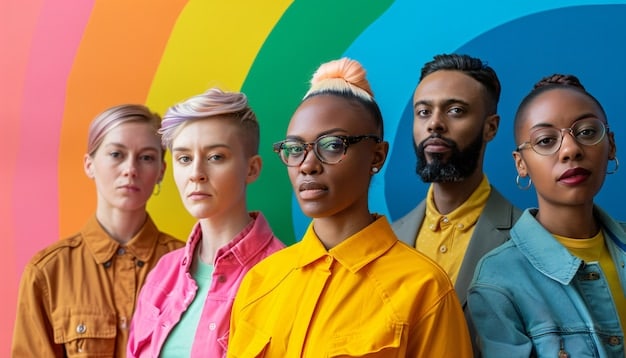Stop Alienating Customers: Avoid Microaggressions in Marketing

Microaggressions in marketing can inadvertently alienate customers by communicating subtle, often unintentional, messages of exclusion or bias, impacting brand loyalty and overall business success unless proactively addressed through inclusive communication strategies and thoughtful content creation.
In today’s interconnected world, effective marketing goes beyond appealing to demographics; it demands a deep understanding of human experience and a nuanced approach to communication. Learning to stop alienating customers: how to avoid microaggressions in your marketing is not merely a moral imperative, but a strategic necessity for brand growth and longevity. This journey requires sensitivity, continuous learning, and a genuine commitment to inclusivity.
Understanding Microaggressions in Marketing
Microaggressions are subtle, often unintentional, expressions or actions that communicate hostile, derogatory, or negative messages to individuals based on their membership in a marginalized group. While the term originated in discussions of race, its application has broadened to encompass biases related to gender, sexual orientation, disability, socioeconomic status, age, and beyond. In marketing, these seemingly minor oversights can have major consequences, eroding trust and alienating potential customers who feel unseen, misunderstood, or even insulted by a brand’s messaging.
It’s crucial to recognize that microaggressions are not always overt acts of discrimination. They often manifest as unintentional slights that stem from unconscious biases or a lack of awareness. For example, a seemingly innocuous stock image that exclusively features able-bodied, young, conventionally attractive individuals might subtly communicate to others that they are not the intended audience. Similarly, language that assumes a universal experience (e.g., “everyone loves summer vacations!” without acknowledging different cultural norms or financial realities) can alienate those whose lives don’t fit that narrow mold.
The impact of microaggressions, despite their “micro” nature, can be cumulative and profound. Imagine continuously encountering marketing materials that subtly exclude you or reinforce negative stereotypes about your group. Over time, this wears down feelings of belonging and trust, leading to disengagement and ultimately, a loss of business. Brands that fail to address these issues risk being perceived as out of touch, uncaring, or even actively discriminatory, damaging their reputation and bottom line.
The Subtle Nature of Exclusion
- Unconscious Bias: Many microaggressions arise from biases we may not even realize we hold.
- Stereotypical Imagery: Relying on outdated or single-story representations of groups.
- Assumptive Language: Using words that imply a universal experience or belief that isn’t true for everyone.
- Lack of Representation: The absence of diverse voices, faces, or perspectives in marketing content.
Marketing teams must cultivate a heightened sensitivity to these nuances. This isn’t about walking on eggshells, but about designing marketing that genuinely welcomes and resonates with the broadest possible audience. It involves moving beyond tokenism and embracing true inclusion, where diversity is not just seen but deeply understood and genuinely reflected in product development, campaigns, and customer interactions.
Understanding what microaggressions are and how they manifest in marketing is the first critical step toward building more inclusive and effective communication strategies. It sets the foundation for proactive measures that can transform a brand’s relationship with its diverse customer base.
Auditing Your Marketing for Unintended Bias
Once you understand what microaggressions are, the next crucial step is to actively audit your existing marketing materials for their presence. This isn’t a one-time task but an ongoing process that requires a critical eye and a willingness to confront potential shortcomings. Begin by reviewing all customer-facing content: website copy, social media posts, advertisements, email campaigns, product descriptions, and even customer service scripts. The goal is to identify patterns of exclusion, generalization, or stereotype reinforcement that might be unconsciously embedded in your messaging.
A comprehensive audit should involve multiple perspectives. What might seem harmless to one person could be deeply alienating to another. Consider forming a diverse internal review committee or, even better, seeking feedback from external consultants or focus groups representing various demographic backgrounds. Their lived experiences can illuminate blind spots that internal teams might miss. Ask specific questions: Does this image truly represent the diversity of our audience? Could this phrase be interpreted in an offensive way by any group? Are we unintentionally trivializing real-world challenges faced by certain communities?
Pay close attention to visual elements. Are your stock photos and video snippets reflective of the diverse world we live in, or do they lean heavily on a narrow ideal? Look beyond basic demographic representation to consider intersectionality – the idea that various social and political identities combine to create unique modes of discrimination and privilege. For instance, it’s not enough to just show diverse races; consider different body types, ages, abilities, and gender expressions. Are characters in your ads shown in a variety of roles, or are they confined to traditional stereotypes?
Key Areas to Scrutinize
- Imagery & Visuals: Are they truly representative and diverse, avoiding tokenism or stereotypes?
- Language & Tone: Is the language inclusive, avoiding assumptions, jargon, or slang that might exclude certain groups?
- Product & Service Positioning: Does your messaging inadvertently suggest certain products are only for specific demographics?
- Customer Service Interactions: Are scripts and training free of biased language or assumptions about customers’ needs or backgrounds?
For written content, analyze word choice, phrases, and metaphors. Does your language consistently assume a specific socioeconomic status or cultural background? Are you using idioms or colloquialisms that might not translate well or could be considered offensive in different contexts? It’s often the subtle cues, rather than overt statements, that carry the heaviest microaggressive weight.
Document your findings meticulously. Catalog examples of identified microaggressions and categorize them by type (e.g., “assumption of normalcy,” “use of outdated terms,” “exoticism”). This documentation will be invaluable for training, developing new guidelines, and tracking progress over time. Remember, the audit is not about assigning blame but about identifying areas for improvement and fostering a more empathetic and effective marketing approach.

Cultivating Inclusive Language and Imagery
Once you’ve identified areas for improvement, the next step is actively cultivating inclusive language and imagery in all your marketing efforts. This involves deliberate choices at every stage of content creation, from initial brainstorming to final publication. The goal is to move beyond mere avoidance of microaggressions and actively embrace representation that empowers, validates, and truly connects with a diverse audience.
When it comes to language, prioritize clarity, respect, and neutrality. Replace gendered language with gender-neutral alternatives whenever possible (e.g., “they/them” instead of assuming “he” or “she” for unknown individuals, “chairperson” instead of “chairman”). Avoid terms that are ableist, ageist, or perpetuate stereotypes about any group. For example, instead of saying “confined to a wheelchair,” opt for “uses a wheelchair.” Review your messaging for any implicit biases that suggest certain activities, products, or roles are exclusive to a particular gender, race, or age group. Think about how your language might sound to someone who is new to your culture or uses English as a second language; simplicity and directness often reduce the chances of misinterpretation or accidental offense.
Visually, the commitment to inclusion must be equally strong. Actively seek out and commission diverse imagery that goes beyond tokenism. This means depicting people of different races, ethnicities, ages, body types, abilities, and gender expressions in authentic, varied roles. Show diversity not just in groups, but also within families and individual narratives. Avoid stereotypical portrayals; if you show a person with a disability, show them as a multifaceted individual living a full life, not just in a context related to their disability. Ensure that skin tones are accurately represented and that backgrounds and settings reflect varied socioeconomic realities.
Best Practices for Inclusive Content
- Persona Development: Create nuanced buyer personas that reflect genuine diversity, not just surface-level demographics.
- Authentic Representation: Partner with diverse creators and models to ensure authentic portrayals.
- Sensitivity Readers: Engage external experts or individuals from marginalized communities to review content for potential biases.
- Beyond Aesthetics: Ensure diversity in your creative team, not just your external-facing content.
Furthermore, consider the context and cultural nuances of your target audience. A phrase or image that is acceptable in one culture might be offensive in another. If you operate in global markets, invest in localization strategies that go beyond mere translation to truly adapt your message to cultural sensitivities. This might involve working with local marketing teams or cultural consultants who understand the specific dynamics of a region.
Finally, remember that inclusive language and imagery are not static. Societal norms and understanding evolve, and so too must your marketing approach. Implement a system for ongoing review and education within your team. Encourage open dialogue, provide resources for learning, and foster an environment where team members feel comfortable pointing out potential areas for improvement. This continuous learning and adaptation are fundamental to building a truly inclusive brand identity.
Training Your Marketing Team for Sensitivity and Awareness
Even with thorough audits and clear guidelines, real change in marketing comes from within the team itself. Training your marketing professionals for sensitivity and awareness is paramount to consistently avoiding microaggressions and fostering a genuinely inclusive approach. This training should go beyond a simple checklist; it needs to cultivate empathy, critical thinking, and a deep understanding of diverse customer experiences. It’s about equipping your team with the knowledge and tools to identify, challenge, and ultimately prevent unintended bias from entering your marketing ecosystem.
Effective training begins with foundational knowledge. Educate your team on the various forms of microaggressions, their common manifestations in language and visuals, and their cumulative impact on individuals and communities. Provide real-world examples, both positive and negative, to illustrate concepts clearly. Discuss the psychological effects of exclusion and how even subtle slights can erode trust and brand loyalty. Emphasize that the intent behind a message is less important than its impact on the receiver.
Beyond theoretical understanding, incorporate practical exercises and role-playing. Have team members analyze sample marketing materials for potential microaggressions, fostering discussion and critical self-reflection. Encourage them to step into the shoes of different customer segments and consider how messages might be perceived from varied perspectives. This can help uncover unconscious assumptions and biases. Bring in diverse speakers or consultants who can share their lived experiences and offer first-hand insights into inclusive communication. Their personal stories can be powerful catalysts for empathy and understanding.
Components of Effective Training
- Unconscious Bias Training: Help team members recognize their own inherent biases.
- Cultural Competency Workshops: Enhance understanding of diverse cultural norms and communication styles.
- Inclusive Language Guides: Provide practical tools and alternative phrasing.
- Empathetic Storytelling: Teach how to craft narratives that resonate authentically with varied audiences.
It is also essential to establish clear communication channels for internal feedback. Create a safe space where team members can raise concerns about potential microaggressions in draft campaigns or existing content without fear of reprimand. Encourage peer review with an inclusive lens. Leadership must model this behavior, actively participating in training sessions and demonstrating a commitment to ongoing learning and improvement.
Finally, make sensitivity training an ongoing process, not a one-off event. Regular refreshers, new workshops addressing emerging issues, and continuous access to resources will ensure that your team remains attuned to the evolving landscape of inclusive communication. Empowering your marketing team with this vital knowledge transforms them into advocates for genuine inclusion, leading to more authentic, resonant, and successful marketing strategies.
Embracing Authentic Representation and Storytelling
To truly stop alienating customers: how to avoid microaggressions in your marketing, brands must move beyond superficial diversity and embrace authentic representation and storytelling. This means portraying diverse customers not as tokens or stereotypes, but as complex, multi-dimensional individuals whose lives and experiences are genuinely valued and understood. Authentic representation builds genuine connection, fostering a sense of belonging that traditional, homogeneous marketing often fails to achieve.
Authenticity starts with deep listening. Instead of making assumptions about diverse communities, engage with them directly. Conduct surveys, hold focus groups, and analyze social media conversations to understand their needs, aspirations, pain points, and cultural nuances. This qualitative data is invaluable for crafting narratives that resonate on a deeper level. Work with diverse content creators, photographers, videographers, and cultural consultants who have lived experiences within the communities you aim to reach. Their insights are crucial for ensuring that your marketing efforts are genuinely reflective and respectful, rather than just outwardly appearing so.
When crafting stories, challenge traditional tropes and stereotypes. For example, if you’re showcasing families, depict a variety of family structures beyond the traditional nuclear unit. If you’re portraying individuals with disabilities, show them active in various aspects of life, not just in roles related to their disability. Highlight the diversity within groups, recognizing that no single individual can represent an entire community. Avoid a “one-size-fits-all” approach to success or happiness, as these concepts vary greatly across cultures and identities.
Strategies for Authentic Storytelling
- User-Generated Content: Encourage customers to share their real experiences with your brand.
- Long-Form Content: Use blogs, podcasts, and videos to tell rich, nuanced stories that defy stereotypes.
- Partnerships: Collaborate with community organizations and diverse influencers.
- Internal Diversity: Ensure your marketing team itself is diverse to bring varied perspectives to the table.
Moreover, authenticity also means being transparent about your brand’s commitment to diversity and inclusion beyond just marketing. Consumers are increasingly discerning and can spot performative allyship. If your marketing showcases diversity, but your internal hiring practices, leadership team, or supply chain lack it, your efforts will likely be seen as disingenuous. Demonstrate your values through tangible actions, not just words and images.
Finally, be prepared to make mistakes and learn from them. The journey toward authentic representation is ongoing, and missteps can occur. When they do, acknowledge them, apologize sincerely, and demonstrate a clear commitment to doing better. This level of humility and accountability further builds trust and shows that your brand’s commitment to inclusivity is genuine and evolving. By embracing authentic representation and storytelling, brands can transform their marketing from merely selling products to building meaningful, lasting relationships with a truly diverse customer base.
Measuring Impact and Continuous Improvement
The journey to avoid microaggressions and build inclusive marketing is not a destination but a continuous process of learning, adaptation, and improvement. To ensure your efforts are effective, it’s crucial to measure their impact and commit to ongoing refinement. This involves setting clear goals, tracking relevant metrics, gathering feedback systematically, and being prepared to iterate and evolve your strategies based on what you learn.
Measuring the impact of inclusive marketing can be multifaceted. Beyond traditional marketing metrics like reach, engagement, and conversion rates, consider qualitative indicators of brand perception. Are there changes in brand sentiment among diverse customer segments? Are you receiving more positive feedback regarding your inclusivity? Monitor social media mentions for any discussions, positive or negative, related to your brand’s representation. Conduct brand perception surveys that specifically ask about feelings of inclusion and representation. Look at customer retention rates within diverse segments—a truly inclusive brand should see stronger loyalty.
Gathering feedback is paramount. Implement formal and informal channels for customers to share their thoughts on your marketing. This could involve direct customer surveys with open-ended questions about inclusivity, feedback forms on your website, or dedicated email addresses for diversity-related inquiries. Internally, maintain the open communication channels established during training, allowing team members to voice observations or concerns from daily interactions or campaign monitoring. Crucially, act on this feedback. Showing that you listen and respond to concerns builds immense goodwill and reinforces your commitment to continuous improvement.
Metrics and Feedback Mechanisms
- Brand Sentiment Analysis: Track public opinion and discussions about your brand’s inclusivity.
- Customer Feedback Surveys: Directly ask diverse customers about their experiences with your marketing.
- Employee Feedback: Foster an internal culture where team members can raise concerns.
- Diversity in Creative Partners: Monitor the diversity of your suppliers and creative agencies.
Establish a regular review cycle for your marketing materials and guidelines. This could be quarterly or bi-annually, where a dedicated team or committee reviews campaigns, revises language guides, and updates training materials based on new insights or evolving societal norms. Stay informed about current events, cultural conversations, and emerging best practices in inclusive communication. The world is constantly changing, and what was considered inclusive a few years ago might be outdated today.
Finally, celebrate progress and learn from setbacks. Acknowledge and reward teams or individuals who champion inclusive initiatives. If a campaign inadvertently misses the mark or receives critical feedback, treat it as a learning opportunity rather than a failure. Analyze what went wrong, adapt your approach, and transparently communicate the changes you’re making. This commitment to continuous improvement demonstrates integrity and helps solidify your brand’s reputation as one that genuinely cares about all its customers. Through diligent measurement and a dedication to evolution, brands can ensure their marketing remains a powerful force for connection and inclusion.
Leveraging Inclusive Communication for Brand Growth
Beyond avoiding pitfalls, actively embracing inclusive communication can be a powerful engine for brand growth and competitive advantage. In a marketplace increasingly defined by conscious consumerism, brands that genuinely champion diversity and inclusion are not just doing good; they are also building stronger, more resilient businesses. Inclusive communication fosters deeper customer loyalty, expands market reach, enhances brand reputation, and attracts top talent, all contributing to sustainable growth in the long run.
When customers feel seen, respected, and understood by a brand, they are more likely to develop a strong sense of loyalty. This loyalty goes beyond transactional relationships; it creates emotional connections that endure even when competitors offer similar products or services. Inclusive marketing speaks directly to the diverse experiences of individuals, fostering brand advocacy and word-of-mouth referrals. Satisfied customers from diverse backgrounds become powerful, authentic ambassadors for your brand, reaching new segments of the market that traditional advertising might miss.
Furthermore, a commitment to inclusive communication significantly enhances brand reputation. In an era where corporate social responsibility is increasingly scrutinized, brands known for their genuine efforts in diversity and inclusion stand out. This positive reputation attracts not only customers but also business partners, investors, and, crucially, top talent. Diverse teams bring varied perspectives and innovative ideas, leading to better problem-solving and more creative marketing solutions that are inherently more inclusive.
Growth Levers of Inclusive Marketing
- Enhanced Customer Loyalty: Building deeper emotional connections with a diverse customer base.
- Expanded Market Reach: Tapping into underserved or overlooked demographic segments.
- Improved Brand Reputation: Standing out as a socially responsible and forward-thinking entity.
- Talent Attraction & Retention: Drawing in diverse, innovative professionals who value inclusive workplaces.
Consider the market potential: neglecting segments due to unintentional microaggressions means leaving significant revenue on the table. By proactively addressing biases and adapting messaging, brands can tap into previously alienated or ignored consumer groups, unlocking new avenues for growth. This isn’t about “niche marketing”; it’s about recognizing the mainstream nature of diversity and crafting universal messages that resonate across multiple identities.
Embracing inclusive communication also drives innovation. When you actively seek to understand and serve a broader range of customer needs and experiences, you are naturally pushed to develop more creative solutions, adapt products, and refine services. This iterative process, fueled by a diverse perspective, leads to more robust offerings and a more agile business model. In essence, inclusive communication transforms from a protective measure against microaggressions into a proactive strategy for competitive differentiation and meaningful, long-term brand expansion. It signifies a future-proof approach to marketing that aligns profits with purpose.
Navigating Challenges and Roadblocks
While the benefits of inclusive marketing are clear, the path isn’t always smooth. Brands will inevitably face challenges and roadblocks when striving to eliminate microaggressions and embrace authentic representation. Navigating these obstacles requires resilience, transparency, and a willingness to learn from inevitable missteps. Understanding common challenges can help brands prepare and respond effectively, ensuring their commitment to inclusion remains steadfast.
One primary challenge is internal resistance, often rooted in unconscious bias or a lack of understanding. Some team members might dismiss concerns about microaggressions as “political correctness” or oversensitivity, failing to grasp their real-world impact. Overcoming this requires consistent education, strong leadership buy-in, and clear communication about why inclusive marketing is essential for business success. It’s about shifting mindsets and fostering a culture where empathy and awareness are prioritized.
Another common hurdle is fear of making mistakes or “getting it wrong.” In attempting to be inclusive, brands might worry about tokenism, cultural appropriation, or inadvertently offending someone. This fear can lead to paralysis or a reluctance to engage with diverse topics. The solution isn’t to avoid engaging, but to engage thoughtfully and humbly. Work with experts, seek feedback, and prioritize authenticity over perfection. It’s better to try, learn, and adapt than to do nothing and perpetuate exclusion.
Common Challenges and Solutions
- Internal Pushback: Provide continuous education and leadership endorsement.
- Fear of Error: Embrace a learning mindset; prioritize authenticity and seek expert guidance.
- Budget Constraints: Prioritize efforts and integrate inclusivity into existing workflows.
- Data Limitations: Seek qualitiative insights and partner with community organizations for direct feedback.
Resource constraints, particularly for smaller organizations, can also pose a challenge. Developing diverse assets, conducting extensive training, or hiring specialized consultants might seem expensive. However, inclusivity doesn’t always require a massive budget. It often begins with conscious choices in existing workflows – choosing different stock photos, refining language in current ad copy, or genuinely listening to customer feedback. Integrate inclusivity as a core value, not an add-on expense.
Finally, navigating the rapidly evolving social landscape itself is a challenge. What is considered appropriate and inclusive changes over time, and brands must stay agile. This requires continuous monitoring of cultural conversations, ongoing education for teams, and a willingness to update guidelines regularly. Public feedback, particularly online, can be swift and critical. Preparing for potential backlash with a clear crisis communication plan that prioritizes accountability and learning is essential. By anticipating and strategically addressing these roadblocks, brands can build resilient inclusive marketing practices that truly stand the test of time.
| Key Point | Brief Description |
|---|---|
| 🎯 Avoid Microaggressions | Address subtle biases in marketing to prevent unintended harm and alienation of diverse customers, ensuring inclusivity. |
| 🔍 Audit & Train Teams | Regularly review content for bias and educate marketing teams on inclusive language and awareness. |
| 🤝 Authentic Representation | Prioritize genuine, diverse imagery and storytelling to build deeper connections with varied audiences. |
| 📊 Measure & Improve | Track the impact of inclusive strategies and iterate based on feedback for continuous business growth. |
Frequently Asked Questions
▼
A microaggression in marketing is a subtle, often unintentional, verbal, nonverbal, or environmental slight that communicates hostile, derogatory, or negative messages to individuals, particularly those from marginalized groups. It can appear in imagery, language, or campaign themes, inadvertently alienating potential customers and undermining brand trust.
▼
Avoiding microaggressions is crucial because they erode customer trust, damage brand reputation, and can lead to lost business. Brands that unintentionally exclude or offend appear out of touch, while those that prioritize inclusivity foster deeper loyalty and expand their market reach among increasingly diverse and socially conscious consumers.
▼
Auditing involves systematically reviewing all marketing content—visuals, copy, and campaigns—for subtle biases. Engage diverse internal teams or external consultants for fresh perspectives. Look for stereotypical imagery, assumptive language, or a lack of representation. Document findings to guide future improvements and training efforts effectively.
▼
Best practices include using gender-neutral language, avoiding ableist or ageist terms, and depicting authentic, varied representations of race, ethnicity, age, body type, and ability. Prioritize working with diverse creators and consider cultural nuances. Regularly review and update guidelines to reflect evolving societal standards of inclusivity.
▼
Inclusive marketing drives growth by fostering deeper customer loyalty, expanding market reach to previously underserved segments, and enhancing brand reputation as a socially responsible entity. It also attracts diverse talent, leading to more innovative solutions and a more resilient business model that thrives in an increasingly diverse consumer landscape.
Conclusion
The journey to stop alienating customers: how to avoid microaggressions in your marketing is not a simple checkboxes exercise, but a profound commitment to empathy, understanding, and continuous improvement. It demands a holistic approach, from auditing existing content and training teams to embracing authentic representation and diligently measuring impact. While challenges may arise, the long-term benefits of inclusive communication—enhanced trust, expanded market reach, stronger brand loyalty, and a more positive societal impact—far outweigh the effort. Ultimately, investing in inclusive marketing is an investment in a more equitable, successful, and future-proof brand.





